“Global Facial Recognition Market to reach a market value of USD 16.8 Billion by 2031 growing at a CAGR of 14.5%”
The Global Facial Recognition Market size is expected to reach $16.8 billion by 2031, rising at a market growth of 14.5% CAGR during the forecast period.
In 2023, the IT and telecom segment acquired a considerable revenue share in the facial recognition market. The IT and telecom sector has been at the forefront of integrating technology into various applications and solutions. Therefore, the IT and telecom segment generated 14.86% revenue share in 2031. With advancements in artificial intelligence (AI), machine learning, and computer vision, IT and telecom companies have developed sophisticated facial detection systems capable of accurately identifying individuals in real-time across diverse environments. Thus, these factors can pose lucrative growth prospects for the segment.
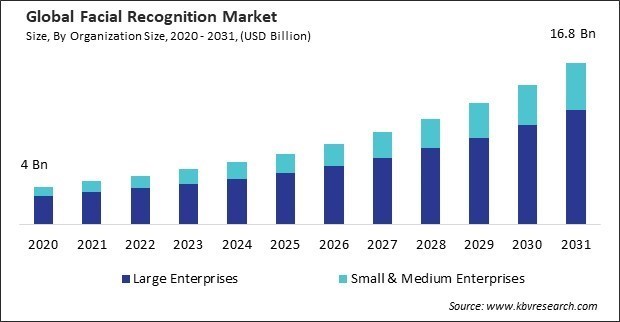
The major strategies followed by the market participants are Product Launches as the key developmental strategy to keep pace with the changing demands of end users. For instance, in 2023, February, Cognitec Systems GmbH expanded its FaceVACS-Entry technology by adding a verification feature to it. Through this launch, the combined service of photo capture and person verification saves travellers lots of time at the border. Moreover, In 2023, June, Daon, Inc. has expanded its IdentityX and TrustX biometrics platforms. Both are designed to target generative AI-assisted fraud and data crime.
Based on the Analysis presented in the KBV Cardinal matrix; Microsoft Corporation is the forerunner in the Market. In March, 2024, Microsoft Corporation expanded its recognition technology by launching a new AI that recognizes faces and groups photos based on relationships, aiming to improve photo management. Through this expansion, Microsoft continues to develop and refine its recognition capabilities, which will also shape the future of digital interaction and privacy. Companies such as NEC Corporation, Thales Group S.A. and Cognitec Systems GmbH are some of the key innovators in Market.
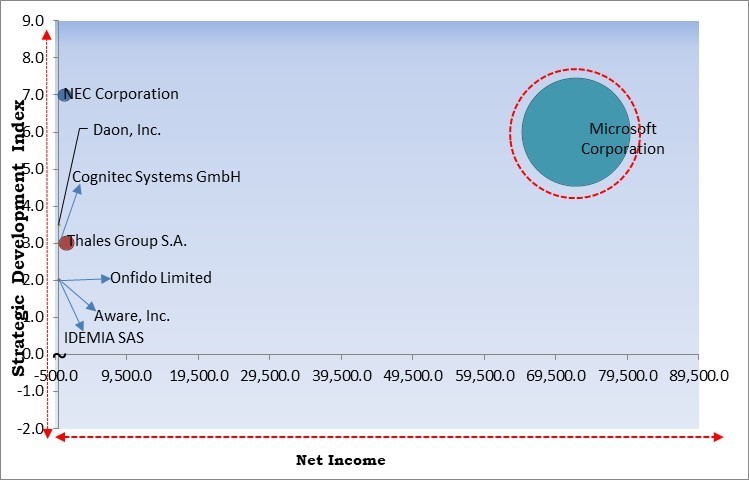
Advancements in sensor technology form a foundational element in enhancing systems. Modern sensors, including high-resolution cameras and depth sensors, enable recognition systems to capture detailed and accurate images of individuals' faces, regardless of environmental conditions. The reliability and versatility of facial detection systems drive their adoption as indispensable tools for identity verification, customer authentication, personalized services, and operational efficiency enhancements across different domains. Thus, these aspects can boost the demand in the market.
Facial detection systems enable comprehensive surveillance by automatically identifying individuals captured by surveillance cameras. These systems analyze facial features and match them against databases of known individuals or persons of interest. Integrated with access control systems, facial recognition technology strengthens physical security measures, safeguarding sensitive areas and critical infrastructure from potential threats or security breaches. Thus, these aspects can assist in the expansion of the market.
Globally, governments and regulatory agencies are implementing more stringent policies in response to concerns regarding privacy infringement, possible misuse of biometric information, and the dangers linked to mass surveillance. Such occurrences erode trust in the technology and endanger the privacy and security of affected individuals. Thus, these factors can hamper the growth of the market.
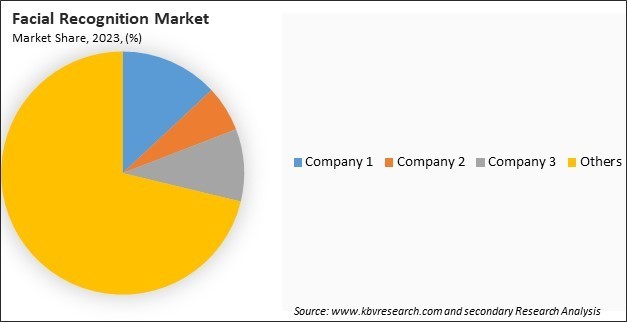
The leading players in the market are competing with diverse innovative offerings to remain competitive in the market. The above illustration shows the percentage of revenue shared by some of the leading companies in the market. The leading players of the market are adopting various strategies to cater to demand coming from the different industries. The key developmental strategies in the market are Acquisitions, and Partnerships & Collaborations.
By organization size, the market is bifurcated into large enterprises and small & medium enterprises. The small and medium enterprises segment procured 25.70% significant revenue share in the market in 2023. The technology has become more affordable and accessible, allowing SMEs to adopt and integrate it into their operations. As the cost of facial detection solutions decreases and the technology becomes more user-friendly, SMEs are more inclined to invest in these solutions to enhance security, streamline processes, and improve customer experiences. Therefore, these factors can fuel the demand in the segment.
Based on deployment mode, the market is divided into on-premises and cloud. In 2023, the cloud segment witnessed 35.55% substantial revenue share in the market. Cloud-based facial detection systems offer scalability and flexibility, allowing organizations to easily scale up or down their computing resources based on demand. This scalability enables businesses of all sizes to deploy technology without the need for significant upfront investments in infrastructure or hardware. Therefore, these aspects can help in the growth of the segment.
Based on offering, the market is divided into software, hardware, and services. In 2023, the hardware segment witnessed 39.63% substantial revenue share in the market. Organizations are increasingly adopting facial detection technology as a more secure alternative to conventional authentication methods like passwords, PINs, and swipe cards in response to the escalating prevalence of cyber threats, identity theft, and fraud. As per Invest India, the nation was among the three Asian nations most severely affected by cyber threats. In 2021, the region witnessed the following most prevalent types of threats: server access attacks (20 percent), ransomware (11%), and data theft (10 percent). Therefore, these aspects can assist in the expansion of the segment.
Based on technology, the market is segmented into 2D, 3D, and facial analytics. The 2D segment held 39.16% substantial revenue share in the market in 2023. One of the primary drivers behind the rising demand for 2D solutions is their cost-effectiveness and affordability compared to their 3D counterparts. 2D facial detection technology typically requires fewer hardware components and computational resources, making it a more budget-friendly option for organizations with limited IT budgets or smaller-scale deployments.
Based on application, the market is divided into access control, attendance tracking & monitoring, security & surveillance, emotion recognition, and others. In 2023, the attendance tracking and monitoring segment witnessed 21.27% substantial revenue share in the market. The technology offers enhanced security features and accuracy in attendance tracking and monitoring applications. Advanced facial detection algorithms can accurately identify and authenticate individuals based on unique facial features, minimizing the risk of identity fraud or buddy punching. Therefore, these aspects can help in the growth of the segment.
By vertical, the market is segmented into government, media & entertainment, education, healthcare & life sciences, automobile & transportation, manufacturing, retail & e-commerce, IT & telecom, and others. The retail and e-commerce segment procured 20.14% significant revenue share in the market in 2023. The technology enables frictionless payment experiences by allowing customers to complete transactions securely and conveniently without the need for physical cash, cards, or mobile devices. Retailers and e-commerce platforms integrate facial detection -based payment solutions, enabling customers to authorize payments using facial biometrics, thereby streamlining checkout processes, reducing transaction times, and enhancing overall payment security. Therefore, these factors can fuel the demand in the segment.
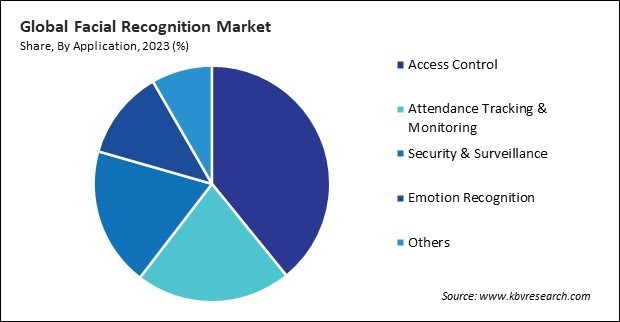
Free Valuable Insights: Global Facial Recognition Market size to reach USD 16.8 billion by 2031
By region, the market is segmented into North America, Europe, Asia Pacific, and LAMEA. The North America segment procured 35.32% the highest revenue share in the market in 2023. Security and safety concerns have been significant drivers of demand for facial detection technology in North America. The region has witnessed increasing security and public safety threats, including terrorism, crime, and cybersecurity breaches, prompting organizations and government agencies to invest in advanced security solutions. Therefore, owing to these factors, there will be increased demand in the segment.
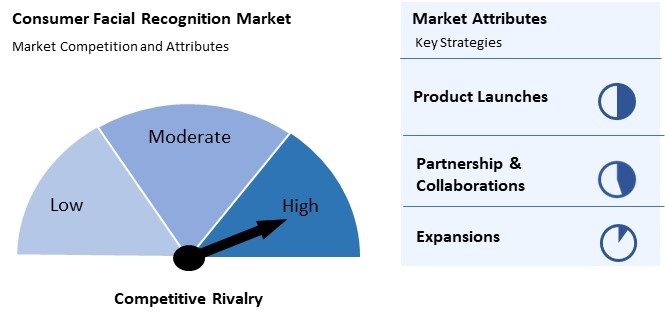
The market is highly competitive, characterized by a diverse range of vendors offering innovative solutions across various industries. Key players in the market include technology giants like NEC Corporation, IBM Corporation, and Microsoft Corporation, alongside specialized facial detection providers such as SenseTime, and Idemia. Competition intensifies as companies strive to differentiate themselves by offering advanced features like emotion recognition, real-time analytics, and robust security measures. Additionally, partnerships, acquisitions, and investments in research and development further fuel competition, driving innovation and expanding market reach. As demand for facial detection technology continues to grow across sectors such as security, retail, and healthcare, competition in the market is expected to remain fierce, fostering continuous advancements and improvements in recognition solutions.
| Report Attribute | Details |
|---|---|
| Market size value in 2023 | USD 5.8 Billion |
| Market size forecast in 2031 | USD 16.8 Billion |
| Base Year | 2023 |
| Historical Period | 2020 to 2022 |
| Forecast Period | 2024 to 2031 |
| Revenue Growth Rate | CAGR of 14.5% from 2024 to 2031 |
| Number of Pages | 398 |
| Number of Tables | 680 |
| Report coverage | Market Trends, Revenue Estimation and Forecast, Segmentation Analysis, Regional and Country Breakdown, Market Share Analysis, Competitive Landscape, Porter’s 5 Forces Analysis, Company Profiling, Companies Strategic Developments, SWOT Analysis, Winning Imperatives |
| Segments covered | Offering, Technology, Organization Size, Deployment Mode, Application, Vertical, Region |
| Country scope |
|
| Companies Included | IDEMIA SAS (Advent International, Inc.), Microsoft Corporation, NEC Corporation, Thales Group S.A., 3M Company, Cognitec Systems GmbH (Salto Systems, S.L.), Aware, Inc., Onfido Limited, Animetrics, Daon, Inc. |
By Organization Size
By Deployment Mode
By Offering
By Technology
By Application
By Vertical
By Geography
This Market size is expected to reach $16.8 billion by 2031.
Growing advancements in biometric technology are driving the Market in coming years, however, Challenges regarding biases and accuracy restraints the growth of the Market.
IDEMIA SAS (Advent International, Inc.), Microsoft Corporation, NEC Corporation, Thales Group S.A., 3M Company, Cognitec Systems GmbH (Salto Systems, S.L.), Aware, Inc., Onfido Limited, Animetrics, Daon, Inc.
The expected CAGR of this Market is 14.5% from 2024 to 2031.
The Large Enterprises segment dominated the Market by Organization Size in 2023, thereby, achieving a market value of $11.9 billion by 2031.
The North America region dominated the Market by Region in 2023, and would continue to be a dominant market till 2031; thereby, achieving a market value of $5.6 billion by 2031.
Our team of dedicated experts can provide you with attractive expansion opportunities for your business.
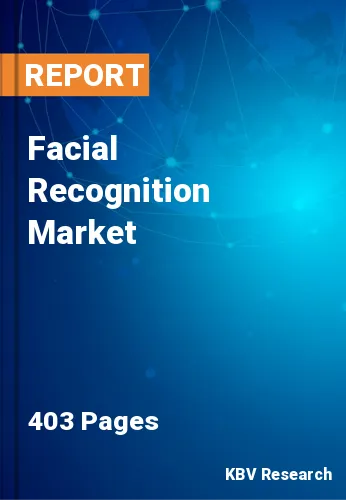
 Drivers
Drivers
 Restraints
Restraints
 Opportunities
Opportunities
 Challenges
Challenges
